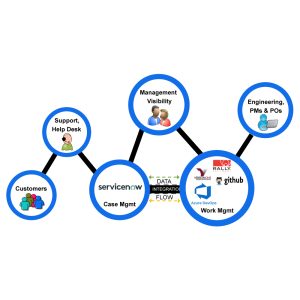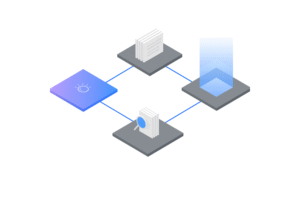Why Data Discovery Is Broken in Most Enterprises
Whether you want to admit it or not, most organizations today are drowning in unstructured information: documents, PDFs, reports, emails, case files, manuals, transcripts, logs, customer messages, and legacy archives sitting untouched in SharePoint, Box, internal wikis, and data lakes.
The result?
- Employees waste hours searching for information.
- Decisions slow down because insights stay buried.
- High-value knowledge becomes tribal — locked inside teams, not systems.
- Customer-facing agents struggle to provide accurate, real-time answers.
- Businesses overspend on manual research, duplication, and compliance risk.
This is the Achilles heel of modern enterprises:
data is plentiful, but insight is scarce.
Traditional keyword search systems were never designed for this complexity. They match exact terms, not intent. They don’t understand context, relationships, entities, or semantics.
That’s why AI-driven data discovery — led by platforms like Watson Discovery — is becoming non-negotiable for digital transformation.
If you’re a decision-maker responsible for customer experience, operations, knowledge management, or analytics, ignoring AI search at this point is simply bad strategy.
What Is Watson Discovery? A Practical Breakdown
Watson Discovery is IBM’s AI-powered enterprise search and knowledge discovery engine. It uses natural language processing (NLP), machine learning, and cognitive search capabilities to extract insights from large volumes of unstructured data.
Here’s the real value:
- It understands content (context, semantics, entities, relationships).
- It answers questions, not just retrieves documents.
- It automates knowledge extraction from messy, unstructured sources.
- It integrates with enterprise workflows, contact centers, and data systems.
- It scales across industries — financial services, healthcare, government, retail, energy.
Watson Discovery turns raw documents into actionable knowledge — instantly searchable, answer-ready, and insight-driven.
It’s not “search.”
It’s cognitive search — a very different game.
Why AI Search Matters More in 2025
1. Enterprise data is exploding
IDC estimates that 80–90% of business data is unstructured.
If you’re managing knowledge systems, you already know the pain.
2. Employees waste enormous time searching
Studies show that employees spend 20–30% of their day searching for information.
That’s operational inefficiency at scale.
3. Manual research is expensive and inconsistent
Manual review of documents, compliance reports, or customer logs is slow and error-prone.
4. Customers expect instant answers
Legacy systems cannot deliver real-time insights in customer support.
5. AI-driven insights create competitive advantage
Companies that deploy cognitive search significantly outperform those that don’t — operationally, financially, and strategically.
If your organization is still relying on keyword search, file explorers, or manual research, you’re losing compounding value every single day.
How Watson Discovery Works (Without the Technical Fluff)
You don’t need a data science background to understand how Watson Discovery delivers value.
Here’s the simplified breakdown:
Step 1: Ingest and Connect Data
Watson Discovery connects to your existing repositories:
- SharePoint
- Box
- OneDrive
- Databases
- Websites
- CRMs
- Knowledge bases
- Internal document systems
- CSVs, PDFs, Word files, logs, and more
It centralizes scattered knowledge into a unified search index.
Step 2: Clean, Structure, and Enrich Content
AI models automatically process the data:
- Removing noise
- Understanding sentence structures
- Identifying keywords, entities, and relationships
- Extracting metadata
- Structuring unstructured content
This is where traditional search systems fall flat. Watson Discovery comprehends content.
Step 3: Build AI-Driven Search Experiences
You can build experiences such as:
- Internal search portals
- Research dashboards
- Customer support search
- Agent-assist search systems
- Compliance search
- Domain-specific insight engines
This turns data into a usable, real-time knowledge layer.
Step 4: Continuous Learning and Optimization
Watson Discovery uses feedback loops to improve:
- Search relevance
- Query understanding
- Ranking logic
- Answer accuracy
This is the “cognitive” part — the system gets smarter over time.
Key Capabilities That Make Watson Discovery a Game-Changer
Let’s break down the features that actually matter — not the marketing buzzwords.
1. Natural Language Search (NLP-Powered)
Employees can search like humans speak:
- “What are the compliance requirements for onboarding?”
- “Show me all risk assessment findings from Q3.”
- “What did customers complain about last month?”
- “Summarize the top issues in support tickets.”
Watson Discovery understands intent, not just keywords.
2. Cognitive Search (Context + Relevance)
The system analyses:
- Meaning
- Sentiment
- Entities
- Relationships
- Domain-specific language
This is far beyond keyword matching.
3. Document Understanding and Summarization
Useful for extracting:
- Key insights
- Risk indicators
- Summaries
- Named entities
- Important passages
Perfect for legal, compliance, healthcare, and financial teams.
4. Semantic Answer Retrieval
Instead of listing documents, it can provide direct answers.
Imagine a customer support agent asking:
“How do I reset a multi-factor authentication token?”
Watson Discovery can pull a direct actionable answer from a 30-page policy manual.
5. Integration with Watsonx and Automation Workflows
Watson Discovery integrates with:
- Watson Assistant
- Watson Orchestrate
- Watsonx.ai
- Watsonx.data
- IBM Cloud Pak for Business Automation
- IBM Cloud Pak for Integration
This transforms AI search into end-to-end automated insight pipelines.
6. Domain-Tuned AI Models
For industries like:
- BFSI
- Healthcare
- Retail
- Energy
- Telecom
- Government
Watson Discovery’s industry-ready models give much stronger accuracy than generic LLMs.
Real-World Use Cases: Where Watson Discovery Delivers Maximum Impact
This is where most enterprise tools fall apart — they promise everything but deliver vague value.
Watson Discovery is different because it solves real operational bottlenecks.
Let’s break it down use-case by use-case.
Use Case 1: Customer Support Knowledge Intelligence
Contact centers depend on fast, accurate answers.
Watson Discovery helps:
- Reduce call handling time
- Improve answer accuracy
- Support agents with instant knowledge
- Enable self-service portals
- Automate FAQs and troubleshooting
Instead of agents manually searching through:
- PDFs
- Manuals
- Ticket history
- Legacy CRM notes
Watson Discovery delivers real-time answers, increasing both CSAT and efficiency.
Use Case 2: Compliance, Legal, and Risk Management
Compliance teams spend thousands of hours reviewing:
- Policies
- Regulations
- Contracts
- Risk reports
- Audit logs
- Legal documents
Watson Discovery automates:
- Document summarization
- Risk extraction
- Policy comparison
- Section-level analysis
- Keyword/phrase detection
- Regulatory mapping
This cuts document review cycles dramatically.
Use Case 3: Research & Knowledge Management
Enterprises generate massive knowledge that typically goes unused.
Watson Discovery enables:
- Centralized research hubs
- Domain-specific knowledge search
- Pattern and trend identification
- Instant synthesis of large collections
This is invaluable for:
- Analysts
- Consultants
- Strategy teams
- Product managers
- Scientific research units
Use Case 4: HR and Internal Knowledge Portals
HR teams can use cognitive search for:
- Policy lookup
- Employee onboarding
- Benefits documentation
- Internal training materials
- SOPs and frameworks
Employees get answers instantly — without raising tickets.
Use Case 5: Healthcare and Clinical Insights
Healthcare depends on:
- Clinical protocols
- Patient history
- Medical literature
- Diagnostic guidelines
Watson Discovery can analyze and surface critical insights quickly, supporting clinicians and researchers.
Business Benefits — Why Enterprises Choose Watson Discovery
1. Faster Decision Making
Watson Discovery eliminates time wasted searching across fragmented systems.
Teams get instant access to answers instead of digging through documents.
This accelerates decisions across operations, support, compliance, and strategy.
2. Improved Accuracy and Reduced Errors
AI-powered interpretation ensures responses are based on verified, consistent information.
It removes guesswork from research-heavy processes like customer support and risk analysis.
The result is fewer escalations, fewer misinterpretations, and stronger audit reliability.
3. Lower Operational Costs
Enterprises cut manual research hours and reduce dependency on subject-matter experts.
Ticket volumes drop as employees and customers self-serve through AI search.
Cost savings compound quickly, with most organizations recovering investment within months.
4. Better Customer Experience
Agents get precise answers in real time, increasing first-contact resolution rates.
Self-service portals become significantly more effective with contextual results.
The net impact is higher satisfaction, shorter interactions, and reduced customer churn.
5. Scalable Knowledge Automation
Watson Discovery expands with your data volume without adding headcount.
New documents, cases, policies, and knowledge sources are automatically absorbed.
This creates a continuously improving knowledge layer that scales across the enterprise.
6. Enterprise Security and Governance
IBM’s governance framework ensures every query and dataset is protected end-to-end.
Access controls, encryption, and audit logs keep regulated enterprises compliant.
This enables AI-driven insights without exposing sensitive or classified information.
Why Watson Discovery Fits Nexright’s Enterprise Solution Framework
Watson Discovery only delivers real enterprise value when it’s implemented with the right architecture, governance, and integration strategy. This is where Nexright makes the difference. As an IBM Solution Partner, Nexright doesn’t just deploy tools — it builds end-to-end cognitive search ecosystems that actually move business outcomes.
Nexright unifies every layer required for successful knowledge automation: AI-driven discovery engineering, clean data pipelines, custom search portals, Watsonx-powered intelligence, and seamless contact-center integration. Industry-specific model tuning ensures search accuracy aligns with real business context, while strong governance, monitoring, and ongoing support keep the system compliant, secure, and continuously improving.
The result is not another standalone AI tool. It’s a fully deployed, enterprise-ready cognitive search foundation that scales, learns, and delivers measurable ROI — exactly what modern organizations expect from next-generation AI search.
FAQs
1. What is Watson Discovery and how is it different from regular search?
Watson Discovery is IBM’s AI-powered cognitive search engine that goes far beyond keyword matching. It understands context, intent, and semantics across unstructured documents like manuals, reports, policies, and emails. Instead of returning links, it retrieves direct, insight-level answers, making it far more effective for enterprise-scale knowledge discovery.
2. How does Watson Discovery improve customer support operations?
By providing real-time, AI-driven answers from large knowledge bases, Watson Discovery cuts response times, improves accuracy, and reduces training overhead for agents. It integrates with Watson Assistant and CRM systems to deliver precise troubleshooting steps and policy information — dramatically improving customer satisfaction scores.
3. Can Watson Discovery handle sensitive or regulated data?
Yes. Watson Discovery includes enterprise-grade security, access control, encryption, and governance. It can be deployed in secure environments and supports industries with strict compliance requirements such as BFSI, healthcare, telecom, and government. Data is scanned, indexed, and retrieved under strict governance rules.
4. How does Watson Discovery support knowledge management?
It unifies scattered enterprise content into a single AI-driven search layer. With NLP and cognitive capabilities, employees can query complex information using natural language and receive accurate insights instantly. This reduces duplicate work, accelerates onboarding, and ensures organizational knowledge is accessible.
5. What role does Watson Discovery play in digital transformation?
AI-driven search is foundational for any modernization strategy. Watson Discovery enables automation, real-time insights, and efficient decision-making by turning unstructured content into actionable intelligence. It helps enterprises eliminate operational bottlenecks and create scalable, insight-driven workflows across departments.
6. How does Nexright help enterprises implement Watson Discovery?
Nexright designs, deploys, and optimizes Watson Discovery environments tailored to industry needs. From data integration and model tuning to governance and automated workflows, Nexright ensures organizations extract actual business value — not just theoretical benefits — from their cognitive search investments.




